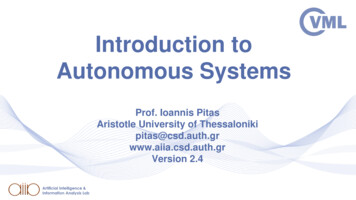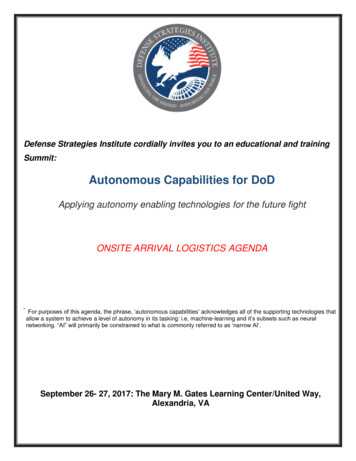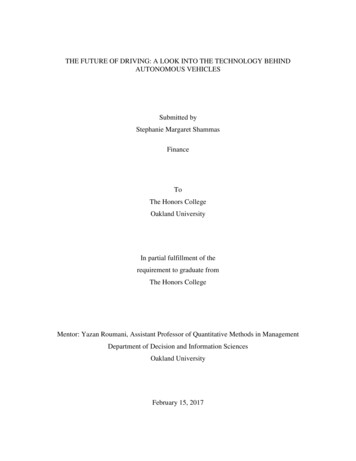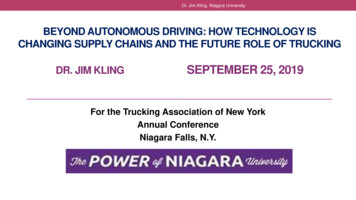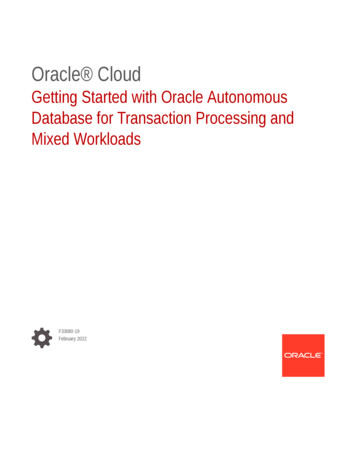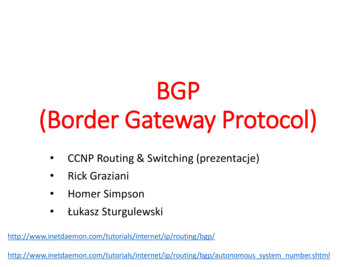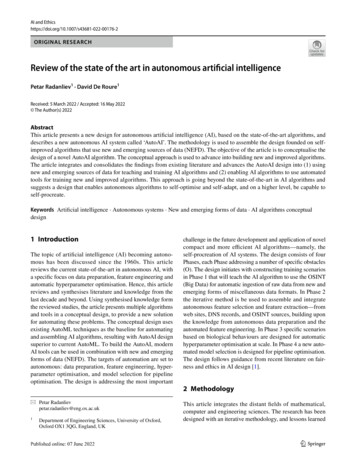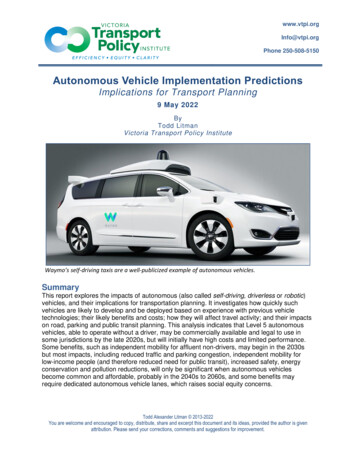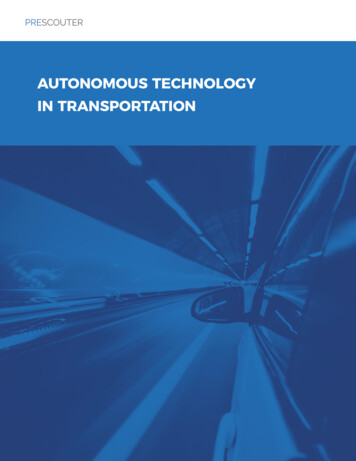
Transcription
AUTONOMOUS TECHNOLOGYIN TRANSPORTATION
Autonomous Technology in Transportation2017
CONTENTSINTRODUCTION3A TIMELINE SNAPSHOT OF AUTONOMOUS TECHNOLOGIESAdam Kimmel4CAR TECHNOLOGIES OF THE FUTURE: MAKING THE ROADS SAFERAmanda Elliott8RESPONSIBILITY IN THE AGE OF DRIVERLESS AUTOMATIONJustin Schaefer11SELF-FLYING PLANES: A ‘JETSONS’ REALITY IS CLOSER THAN YOU THINKPaula Hock14AI’S FUTURE IMPACT ACROSS THE TRANSPORTATION INDUSTRYAnu Antony16A GLIMPSE AT THE FUTURE: TAXIBOTSFrancois Callewaert20
INTRODUCTIONFor a number of years, the autonomous operation of vehicles, machinery, and other mechanics hasseemed to be a thing of the distant future. In reality, technology today stands at a precipice: ahead liesa world full of driverless cars, autonomous public transport vehicles, and an exciting wealth ofopportunities we are only beginning to realize. This autonomous land ahead, however, is only availablewith a great leap of faith- faith that autonomous systems are safe, capable, and robust. In time, mostconsumers will find that the leap of faith required is little more than a step, the next step intechnological evolution.This paper provides an overview of several facets of autonomous technology within thetransportation industry. First, we examine the technological developments that led us here.Interestingly, the timeline begins several hundred years ago with da Vinci’s Self-Propelled Cart (1480).Next, we arrive at the present day with the development of various facets of an autonomous systemmaking driverless vehicles a reality. These include system overrides, different types of detectionmechanisms, traffic alerts, and more.Technologies such as those described pose ethical questions as well as technical ones. For instance,how safe must an autonomous vehicle be to be “safe enough”? This and more is covered in the nextsection.Not surprisingly, automation has begun to touch other vehicle types as well, including aircraft. Wenext delve into the recent developments in aviation making strides toward unmanned flights, whichstart in autopilot capability and push much farther ahead.Finally, the two remaining sections of the paper turn our eyes toward the road ahead. What pieces ofautonomous technology will disrupt the transportation industry? How quickly? What will the averageperson’s commute look like in 20 years?In assessing impact and reimagining what we can do with the technology at hand, you will have aglimpse into a truly autonomous future.3
A TIMELINE SNAPSHOTOF AUTONOMOUS TECHNOLOGIESAdam KimmelAutonomous (or self-directed) technology istransformingindustriesrangingfromautomotive to insurance to healthcare. Theopportunity to realize passive yet intelligentcontrol is enabling innovation almost as fast asits creators can dream it up. However, the speedof advancement makes us wonder how therevolution started. The following is a timeline ofthe most important technologies that led to theadvent of autonomous transportation.A self-propelled cart replica at museum Clos Lucé.(Source: Wikipedia)Autonomous PropulsionLeonardo da Vinci –Autopilot GyroscopesThe Self-Propelled Cart, 1480Theinventorprescribedapathforaself-propelled cart that was intended for use inthe theater. Powered by high-tension spiralsprings, the cart traveled along the path towardits intended destination. It also boasted aremotely-controlled handbrake. While the cartdid not respond to external stimuli, theautomotive community considers the cart one ofthe first automated mobile vehicles in history.Wiley Post –Mechanical Mike (air travel), 1933Sperry Gyroscope Co. developed a prototypeautopilot for Post’s flight around the world in1933. It employed gyroscopes that were used tocollect data from all three dimensions. This datawas used to calculate the position and motion ofthe plane regardless of conditions, enabling4
simultaneous flying and navigating. For thatdisproved the primary assumption of Adams’sreason, gyroscopes have proven transformativeresearch. Five years later, Les Earnest proposedin the development of autonomous vehicles, andconverting the cart into a road vehicle usingare still used today.video as its navigation. This new applicationemployed a computer to control the cart basedon images received through the video camera.The cart was one of the first instances that usedCruise Controla battery as the primary model of power, pairingRalph Teetor (Dana, Inc.), 1945-1958electric drivetrains with autonomous driving.German automotive engineer Ralph Teetor ofTsukuba Mechanical –Dana Corp. developed conceptualized cruisePassenger Vehicle, 1977control while riding in his attorney’s car. Therocking motion of acceleration and decelerationExtending the work started by the Stanford Cart,inspired him to develop a mechanical throttle toJapanese firm Tsukuba fabricated a vehicleregulate the vehicle’s speed. Development overcapable of traveling 20 miles per hour using twothe next decade led to commercialization of thecameras attached to the outside of the car.technology that first autonomously regulated thespeed of a car. Following commercialization,cruise control was first offered by GM on itsDynamic Vision1959 Cadillac models.Ernst Dickmanns – VaMoR, 1987Like many key inventions that have led toVehicle-Mounted Cameraautonomous cars, Dynamic Vision was born outJames Adams and Les Earnest (Stanford Univ.) –Stanford Cart, 1961-71of the aerospace industry. Dickmanns worked onspace shuttle orbiter re-entry. When modifyingthe path to shuttle re-entry proved impracticalengineeringdue to the fragility of the spacecraft itself,graduate student James Adams built the cart toDickmanns transitioned his research to a remotevalidate the assumption that a car could drive onsensorthe moon while being controlled on Earth. Thesatellite.original cart used a car battery to drive and aapproached him to develop (among other things)television camera on the top to navigate. Anan autonomous car to commemorate nial of their first car in 1886. Dickmannsthemoonand his team outfitted a five-tonne Mercedes van
withcamerasandsensorstosenseitscontinuously and has a depth perceptionaccuracy within 2 cm. Most images of currentenvironment and to process information.autonomous vehicles include a LIDAR sensorThe hurdle that Dickmanns finally cleared wasthat sits on the roof of the vehicle. Coupled witheliminating the delay between informationmodern GPS systems, LIDAR represents thereceipt, process, and response using computersmostthat did not yet have the processing power ofmomentum in the autonomous vehicle industry.enablingtechnology for therecenttoday’s versions. His team developed a solutiontermed the “4D approach”, with the fourthThe use of a battery to provide power and thedimension being a predictive estimate of spatialinclusion of gyroscopes and lasers are largelypositioning based on data from the other three.responsible for the current state of autonomousThisofvehicle industry. While significant technicalpreviously-captured images to areas of highchallenges remain, such as external objectcontrast, or changes in color or density.discernment as an example, we are closer toshiftedfocusfromthehistoryself-driving cars than ever before due in largedegree to these advanced technologies.LIDAR, 1960s-presentThe wide scale use of lasers in the 1960s enabledthe invention of LIDAR (light detection andranging). Like its predecessors SONAR (sounddetection and ranging) and RADAR nsional map around the vehicle bysending laser pulses to a remote object. The mapAs shown in the timeline above, technologyinnovation is constantly pushing us past existingboundaries and paradigms. While cialization and adoption, they can alsolead to the creation of new building blocks thatcan be used to build the next transformativeis created by measuring the time it takes the laserto return to the origin. It is this map that triggersthe autonomous controls to respond in real time.Along with autonomous vehicles, LIDAR has hadsignificant impacts in oceanic applications orelineapplication wasspaceexploration, where it was used in the Apollo 15mission to map the surface of the moon.At its present stage of development forautonomous vehicles, the LIDAR box spins 360 A LIDAR unit mounted to an autonomous car(Source: Wikipedia)6
platform. Just as the current autonomouscommercialization of these vehicles may verytechnology was largely born out of the aerospacewell lead to innovation in a future industry weindustry, new technology developed throughhave not yet even considered.ADAM KIMMELAdam is one of Prescouter’s Global Scholars, as well as the Principal Writerat ASK Consulting Solutions, an engineering content writing and researchconsulting firm. He specializes in the alternative energy, transportation,consumer products, IT and healthcare IT industries. Adam earned a B.S. inChemical Engineering from Penn State and an M.S. in MechanicalEngineering – Energy Systems from Marquette University. His master’sthesis at Marquette defined new transport correlations for steam-methanereforming in non-adiabatic, process intensified catalytic reactors.7
CAR TECHNOLOGIES OF THE FUTURE:MAKING THE ROADS SAFERAmanda ElliottThere’s a lot changing in the automotiveCompaniesindustry. Most surprisingly, having a driver’sMercedes-Benzlicense won’t be a milestone in the futuredetection systems into their models for carbecause our cars will be able to drive andanimal2. Infra-red headlightsAs we take a hands-off approach to driving, willseat belts and airbags remain the car safetylikeDuringbad weather likefog,snow andthunderstorms, driving conditions become moreOne thing is for certain, sensors and cameras willplay a major role in car safety. We are going tolook at 10 future car technologies to lookforward to.dangerous. To help drivers see further in poordriving conditions, car companies like Audi, Ford,BMW, and Toyota and turning to infraredheadlights.3. Remote vehicle shut downSometimes cars need to be shut down because10 Future Car Technologies:of reckless driving or missed car payments.Remote vehicle shutdown will allow technology1. Animal detectionRoad kill is a problem. In America, there are about1.5 million car accidents every year from deeralone,accordingto AAA. Withnew cartechnology like radars and infrared cameras, thecar willbeabletodetectautomatically apply the brakes.animalsandto shut down a car within a 50m radius. GM andToyota are some of the car companies working onthis technology.With this technology, there are other logistics toconsider like when to turn off a car. There is still8
inertia and gravity in play and this technologylikecould potentially disengage a car in mid-traffic.infrastructure alerts include Toyota, GM ote vehicle shutdown has already beeninstalled in an estimated 2 million vehicles in2014 in the United States alone, according toCartrade.6. Augmented reality windshieldAugmented reality will play a large role in futuretechnologies and it might start with the4. Driver override systemwindshield on cars. While we use windshields toWhile all cars might not be autonomous, theymight be semi-autonomous. With the driveroverride system, the car will be able to apply thebreaks even in some cases when a driver isaccelerating.CarcompanieslikeNissan,Volkswagen, Volvo and Toyota are investing insee the road, the car’s dashboard might actuallybe part of the windshield to provide real-timedata on speed, fuel, temperature and directions.Companies like Jaguar, BMW, Ford and GM areinvesting in augmented reality windshields.driver override systems.7. Biometric vehicle access5. Dynamic infrastructure alertsCar companies are investing in this future cartechnologytoconnectwithreal-timeinfrastructure maps to monitor changing drivingparameters and road conditions. This will be likeGoogle Maps, but with more real-time databased on construction and traffic and hazards9There’s a more personalized driving experiencecoming in the future. Biometric vehicle accesswould take away your keys and put them literallyin your hands. With this future car technology,drivers will be able to use their fingerprints tounlock their cars and even authenticate thedriver.
It would also help with car theft, through thisIn the United States, some states have alreadypersonal biometric tracking and authentication.legalizedMitsubishi,Mercedes-Benz and Ford have all startedFord,Mercedes-Benz,andVolkswagan are some of the car companiesself-drivingcars.Lexus,Tesla,working on self-driving cars.currently investing.8. Network-based traffic alertsTraffic is one of the most challenging or boringparts to anyone’s commutes. Well, what if youcould send messages to other drivers on the roadabout current traffic conditions? With thenetwork-based traffic alerts, drivers will benotified of congestion and will be able to re-routebased on real-time data. According to Quoteme,the network-based traffic alerts will bring about a97 percent increase in data traffic in the next 10years.10. Active health monitoringActive health monitoring technology might helphealth related accidents – like driving for too longor with low blood pressure or while intoxicated.“The system will be able to detect if someone ishaving a cardiovascular issue, for example aheart attack, and could also be used to detectthe symptoms of other conditions such as highblood pressure or electrolyte imbalances. Thisnot only benefits the driver; but also could makethe roads safer for all users.”Companies like GM, Volvo, and BMW arecurrently working on these car technologyapplications.Dr. Achim Lindner, Ford Research Centermedical officerFord, Mercedes-Benz, and Lexus have started to9. Autonomous carswork on this new car technology.One of the most talked about trends isautonomous cars, especially with recent pilotprograms by Uber for both passenger andcommercial use.AMANDA ELLIOTTAmanda Elliott is an experienced content curator and marketing campaignmanager. She held the role of Marketing Coordinator and Journal Editor atPreScouter from 2016 to 2017. In her free time, Amanda interviews otherChicago startups in her blog, Windy City Cosmo.10
RESPONSIBILITY IN THE AGE OFDRIVERLESS AUTOMATIONJustin SchaeferSelf-driving cars are coming, and they will almostThe US Energy Information Agency predicts thatundoubtedly be the predominant mode ofelectric vehicles will make up 8 percent of the UStransportation on our roads in the next fewmarket share by 2025, and we can expect thosedecades. The first driverless cars hit the streetscar models to have integrated self-drivingin 2015, and already, they are beginning to boomsystems as standard options relatively soon.in controlled areas. For instance, NuTonomy willbe introducing driverless taxis to Singapore inEven2018, and in 10 other cities around the world byself-driving systems will be available for purchase2020.and the combination of newer technology, pricebeforethat,however,aftermarketdifferences and varying efficacies of theseIndustry Giants Taking on the DriverlessInnovation Challengesystems will cause standardization or even legalissues (for instance the legal questions raised bythe fatal Tesla accident in May of 2016).Major players in the car market such as Volvo,Ford, Tesla, GM, and even Google are all makingCan Man and Machine ‘Coexist’ Safely on thegreat strides in driverless innovation. Google andSame Road?Ford, for instance, agree that self-driving carsneed to be fully autonomous rather than a hybridhuman and robot driver, due to the fact thatdrivers start to trust the technology and stoppaying attention. By literally handing over thewheel to robots, it becomes clear that newconversations and laws about safety andresponsibility will need to be processed.11During this period, when manually-driven andautomatically driven cars of many different typesand grades coexist on the same streets, aninteraction between the two groups is bound tobe less than cordial. Early on in their inception,driverless cars had higher accident rates than
regular cars, despite being touted as the ultimateenough to slow down to allow the truck toin safe-driving features. The programming ofmerge, there are thirty people who have lessthese vehicles is simply not capable of dealingcharity in their hearts. So, our lamentable truckwith the limitless, sometimes chaotic, variablessits and waits, with traffic backing up untilseen on the road. It is then apparent thatsomeone comes along to relieve the arwhenanencountersthedecidedly un-algorithmic driving style of humans.For a portent of things to come, one need lookonly to your local freeway on-ramp, and thelong-haul trucker that is trying to merge intotraffic. Today, truckers in heavily congested areasroutinely have to force themselves into a lane byslowly moving over and leaving it to the‘4-wheelers’ to stop in time or get out of the way.The reason this happens is that drivers choosenot to let the truck in. It is safe to say that anautomaticallydriventruck wouldnotbeprogrammed to merge somewhat forcefully. It isalso safe to say that for every one person kindHow Will Driverless Cars Make Decisions?This is just one example. One thing we can all beton is that there will be many more instances ofuncharted robot-human interactions. The kinksin these systems will inevitably be worked out,and as machine learning and artificial intelligencebegin to come into their own, the problems willbecome less common.Before that happens, though, I believe thatdriving algorithms should be made public and thepublic should be trained on how driverless carswill react in any given situation. For example, the12
ethical dilemma of whether a self-driving car willdrift until traction is restored, then the cars inrespond to prioritize the safety of a pedestrian orfront of it should be aware of that scenario.the driver is still up for consideration. But onceEither way, knowing what will happen in anythat decision is made in the courts, people needgiven situation might not prevent accidents, butto be aware of it so they can plan accordingly.it might save lives by making other motorists andnon-motorists more prepared.Will an out-of-control car on an icy road driftaimlessly and hope to regain traction, or will itDriverless cars and trucks are here, and as theywork to get to the side of the road as quickly asare being tested, it is up to us to know how topossible to arrest its momentum? And what ofreact in situations that might be out of the car’sthe man walking his dog on the sidewalk that iscontrol. It is up to the programmers to give ushit when the car eventually hits that curb? If thethat information.vehicle is programmed to swerve immediatelyand forcefully, that dog walker should be awarethat that is a real possibility. If the car isprogrammed to stop trying to correct and justJUSTIN SCHAEFERJustin received his PhD in Comparative Biomechanics and FunctionalMorphology from the University of California, Irvine. His dissertationresearch focused on describing and modelling the mechanical effects ofmorphological changes to serially repeated skeletal elements in sharks,stingrays and skates. During his studies, he also worked as an assistantprofessor of medicine at the UC Irvine School of Medicine. After apost-doctoral research/teaching fellowship at Brown University School ofMedicine, he began a career as a medical educator teaching gross anatomyto medical students at schools such as UCLA and UCI. Justin thentransferred to PreScouter as a Project Architect and left in 2017.When not working, Justin enjoys teaching Martial Arts, working on his ‘71Chevelle, rockhounding, spearfishing, and playing with his 5-year old son.13
SELF-FLYING PLANES: A ‘JETSONS’REALITY IS CLOSER THAN YOU THINKPaula HockWith recent buzz surrounding automation, mostthis can happen only when the technology cannotably autonomous vehicles, the next questionoperate on the expected levels of safety,to ask is what comes next? For Boeing, the nextintegrity, and availability as is currently provided.step is self-flying planes, a step they may beginto take as early as next year.Current Autonomous TechnologyBoeing’s Recent AnnouncementIt should come as no surprise to note that a fairamount of autonomous systems already exist inAt the Paris Air Show held in June of 2017,aviation. Most commercial aircraft fly onBoeing’s vice president for product developmentauto-pilot throughout a high percentage of theMike Sinnett announced the company’s vision forflight. Radio navigation (VOR) and GPS are usedsolving a foreseen shortage of pilots withtogether with auto-pilot for flight betweenautonomous behavior. He sees a need for overwaypoints. Even a variety of auto-landing40,000 commercial aircraft over the next 20systems exist to land an aircraft in low visibilityyears to keep up with air travel demands. This, ofconditions.course, would require approximately 600,000more pilots, the training of which is an expensiveThe gap between today’s technology and theand time-consuming process.flying robots of the future �edBoeing’soperations. In the case of autonomous vehicles,expectation to have in-flight tests by 2019. Theymost experts agree that autonomous drivinganticipate a transition away from a requiredsystems will reduce the US’s annual 40,000aviator for tactical operation in favor of antraffic death toll, a low expectation barrier forWithSinnett’sinterviewcomesautonomous vehicle operation system. However,14
incoming systems. In aviation, the number toCarnegie Mellon University’s Robotics Institutebeat is zero: no one has died in a jet crash in thehas been working to develop smart UAVs withU.S. since 2009. This is no small task.the capability of avoiding unanticipated objectsin their flight paths. In April, the Air ForceAdditionally, though Sinnett acknowledged thatResearch Laboratory (AFRL) and Lockheedlanding software could handle auto-takeoffs asMartinwell, no system has actually compiled all themanned/unmanned aircraft team in a strikesystems together yet. This technology does needpackage to improve combat efficiency andto undergo development to come to lseems to be focused on a distinctly differentonlycompany/research team in the development ofautomated flight technology. Teams in academia,the aviation industry, and government agenciesalike have been working on various aspects ofthe technology for several years.Successful tests have been performed to date,both for unmanned aerial vehicles (UAVs) and formanned/unmanned teaming. A researcher ataInterestingly, one of Boeing’s major competitorsThe Future of Automated dular,self-piloting flying car concept back in March.Their Vahana flying autonomous vehicle projecthas debuted a concept design at the GenevaMotor Show after several months of discussion.With an eye beyond the skies, NASA has alsobegun research on automated planes andspacecrafts.Ifthelogicalnextstepsofautomation are moving from vehicles to aircraft,why shouldn’t space exploration be next?PAULA HOCKPaula is one of PreScouter's Project Architects. She specializes in the transportationindustry. She works with scholar teams to provide clients with cutting-edge,actionable information to improve their businesses. This can mean problem solving,process optimization, entering new markets, assessing intellectual property, andmore. Paula earned her B.S. from DePaul University in Chemistry before continuingon to her Ph.D. in Physical Chemistry at the University of Pittsburgh. There, herresearch focused on characterization of organic semi-conducting thin films for use inelectronic devices. That is also where she started with the PreScouter GlobalScholars program in August of 2014. After working as a scholar for a few months,she became a Team Leader before eventually taking a full-time role with PreScouter.15
AI’S FUTURE IMPACT ACROSS THETRANSPORTATION INDUSTRYAnu AntonyResearch into artificial intelligence (AI) hasAI uses observed data to make or even predictexperienced a surge in the last few decades. Thisdecisions appropriately. NNs and GAs are perfectwas built largely on pioneering results from theAI methods to deal with these types of60’s and 70’s, including the utilization ofunpredictability. AI has been in development andadvanced neural networks (NNs). It has evenimplemented in a variety of ways. Sometaken inspiration from biological behavior forexamples are given below:methods like fuzzy logic or genetic algorithms(GAs).Improvement of Public Safety: Safety ofcitizens when traveling by public transport inA major area where AI has taken off is intransportation. Media hype has covered quite abit of recent advances, like self-driving Ubers orTesla’s new semi-autonomous trucks, but whaturban areas is improved by tracking crimedata in real time. This will also enable thepolicetoincreasetheirefficiencybypatrolling and keeping their citizens safe.else lies ahead? How will AI impact thisCorporate Decision Making: The road rediction methods to forecast their volumeHow AI Can Help TransportationTransportation problems arise when systembehavior is too difficult to model according to apredictable pattern, affected by things like traffic,human errors, or accidents. In such cases, fiesplanning.Additionally, several decision-making toolsfor transport can be designed and run by AI.This willaffectinvestmentsmadebycompanies in the future in a productive way.unpredictability can be aided by AI.16
Autonomous Vehicles: Self-driven cars andPedestrian Safety: The use of AI to predicttrucks have been of high interest in the lastthe paths of pedestrians and cyclists willseveral years. In the commercial sector, Uberdecreaseand Elon Musk have produced self-drivingallowing for more diverse transportationtrucks to reduce the number of accidents onusage and an overall reduction in emissions.trafficaccidentsandinjurieshighways and increase productivity.Traffic Patterns: Transport is greatly affectedThe Impact of AI in Transportby traffic flow. Traffic congestion in the USBenefits:costs around 50 billion per year. If this datais adapted for traffic management via AI, itwill allow streamlined traffic patterns and asignificant reduction in congestion. Severalsimilar systems are already in place. Forexample, smarter traffic light algorithms andreal-time tracking can control higher andlower traffic patterns effectively. This canalso be applied to public transport for optimalscheduling and routing.17In October 2016, Uber announced a driverlesstruck made by Otto that successfully drove 120miles at 55 mph without any issues. Additionally,Daimler trucks has produced an 18-wheelersemi-autonomous truck with an auto-pilotsystem.Costs of labor in this sector will continuallydecrease with increased use of AI, providing
higher profits for industry players. The issue ofutilizing these solutions, as their infrastructure islong driving hours and stopping for a break willnotno longer be a concern with fully automatedmaintenance and repairs. It will be a long timefleets.before AI can become a reality there.Beyond straightforward labor costs, safety andIncreasing focus on AI also presents a dilemmatraffic accidents will be majorly affected by AI.forThe number of accidents involving truck driverscontribute to the company turnover by 3-10%.at night is a large issue and can be significantlyThis makes it a very important factor in corporateimproved with the use of smart unmannedeconomies as a whole. All existing businesses willvehicles. The personnel and financial costs ofneed to engage in, develop, and implement AIthese accidents are quite substantial. Auto-pilottechnologies to remain a competitor in theor complete unmanned vehicles can allow thetransportationdriver to have a snooze without causing severetransportation logistics as well, as it is used in theaccidents. Some AI trucks even have a specialsupply chain of operations and manufacturingfeature of predicting accidents as well as healthand even predicting the time and total cost of theissues of people around the truck like detecting aentire ry.ofprovidingtransportThiscostsaffectsheart attack and alerting the emergency servicesautomatically with the location and details ofThe Futurediagnosis.Drawbacks:By 2020, it is estimated that there will be 10Automated trucking has sparked a hot debatemillion self-driving vehicles and more than 250among 3.5 million truck drivers in the US alone.million smart cars on the road. Tesla, BMW, andDevelopments would mean autonomous trucks,Mercedesships, aircraft or trains slated for the future, alongautonomous cars, and they have proven to bewith any future vehicles becoming completelyvery successful.havealreadylaunchedtheirunmanned. Job flow is thus a major concern fortruck drivers, taxi drivers, and other members ofExperts like Elon Musk and Stephen Hawkingthe industry. Social experts have argued that jobpredict that AI can be a grey area when the rootskills can be shifted or evolved to other sectors,of AI decisions cannot be comprehended bybut tensions remain high.humans. Stephen Hawking warned at the WebSummit tech conference in Lisbon that:Implementation around the world presentsanother major issue. Undeveloped and thirdworld countries face enormous challenges in18
“Unless we learn how to prepare for, and avoid,the potential risks, AI could be the worst eventin the history of our civilization. It bringsdangers, like powerful autonomou
seemed to be a thing of the distant future. In reality, technology today stands at a precipice: ahead lies a world full of driverless cars, autonomous public transport vehicles, and an exciting wealth of opportunities we are only beginning to realize. This autonomous land ahead, however, is only available

